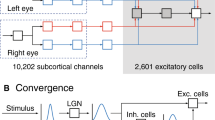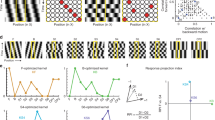Abstract
Sensory experience begins when neural circuits in the cerebral cortex are still immature; however, the contribution of experience to cortical maturation remains unclear. In the visual cortex, the selectivity of neurons for oriented stimuli at the time of eye opening is poor1,2,3,4,5 and increases dramatically after the onset of visual experience3,4,5,6,7,8. Here we investigate whether visual experience has a significant role in the maturation of orientation selectivity and underlying cortical circuits9,10,11,12 using two forms of deprivation: dark rearing, which completely eliminates experience, and binocular lid suture, which alters the pattern of sensory driven activity13. Orientation maps were present in dark-reared ferrets, but fully mature levels of tuning were never attained. In contrast, only rudimentary levels of orientation selectivity were observed in lid-sutured ferrets. Despite these differences, horizontal connections in both groups were less extensive and less clustered than normal, suggesting that long-range cortical processing is not essential for the expression of orientation selectivity, but may be needed for the full maturation of tuning. Thus, experience is beneficial or highly detrimental to cortical maturation, depending on the pattern of sensory driven activity.
This is a preview of subscription content, access via your institution
Access options
Subscribe to this journal
Receive 51 print issues and online access
$199.00 per year
only $3.90 per issue
Buy this article
- Purchase on Springer Link
- Instant access to full article PDF
Prices may be subject to local taxes which are calculated during checkout



Similar content being viewed by others
References
Wiesel, T. N. & Hubel, D. H. Ordered arrangement of orientation columns in monkeys lacking visual experience. J. Comp. Neurol. 158, 307–318 (1974).
Hubel, D. H. & Wiesel, T. N. Receptive fields of cells in striate cortex of very young, visually inexperienced kittens. J. Neurophysiol. 26, 994–1002 (1963).
Frégnac, Y. & Imbert, M. Early development of visual cortical cells in normal and dark-reared kittens: the relationship between orientation selectivity and ocular dominance. J. Physiol. 278, 27–44 (1978).
Chapman, B. & Stryker, M. P. Development of orientation selectivity in ferret visual cortex and effects of deprivation. J. Neurosci. 13, 5251–5262 (1993).
Chapman, B., Stryker, M. P. & Bonhoeffer, T. Development of orientation preference maps in ferret primary visual cortex. J. Neurosci. 16, 6443–6453 (1996).
Gödecke, I., Kim, D. S., Bonhoeffer, T. & Singer, W. Development of orientation preference maps in area 18 of kitten visual cortex. Eur. J. Neurosci. 9, 1754–1762 (1997).
Crair, M. C., Gillespie, D. C. & Stryker, M. P. The role of visual experience in the development of columns in cat visual cortex. Science 279, 566–570 (1998).
Blakemore, C. & Van Sluyters, R. C. Innate and environmental factors in the development of the kitten's visual cortex. J. Physiol. 248, 663–716 (1975).
Gilbert, C. D. & Wiesel, T. N. Columnar specificity of intrinsic horizontal and corticocortical connections in cat visual cortex. J. Neurosci. 9, 2432–2442 (1989).
Durack, J. C. & Katz, L. C. Development of horizontal projections in layer 2/3 of ferret visual cortex. Cereb. Cortex 6, 178–183 (1996).
Ruthazer, E. S. & Stryker, M. P. The role of activity in the development of long-range horizontal connections in area 17 of the ferret. J. Neurosci. 16, 7253–7269 (1996).
Bosking, W. H., Zhang, Y., Schofield, B. & Fitzpatrick, D. Orientation selectivity and the arrangement of horizontal connections in tree shrew striate cortex. J. Neurosci. 17, 2112–2127 (1997).
Sherman, S. M. & Spear, P. D. Organization of visual pathways in normal and visually deprived cats. Physiol. Rev. 62, 738–855 (1982).
Chapman, B., Gödecke, I. & Bonhoeffer, T. Development of orientation preference in the mammalian visual cortex. J. Neurobiol. 41, 18–24 (1999).
Miller, K. D., Erwin, E. & Kayser, A. Is the development of orientation selectivity instructed by activity? J. Neurobiol. 41, 44–57 (1999).
Sengpiel, F., Stawinski, P. & Bonhoeffer, T. Influence of experience on orientation maps in cat visual cortex. Nature Neurosci. 2, 727–732 (1999).
Krug, K., Akerman, C. J. & Thompson, I. D. Responses of neurons in neonatal cortex and thalamus to patterned visual stimulation through the naturally closed lids. J. Neurophys. 85, 1436–1443 (2001).
Shouval, H. Z., Goldberg, D. H., Jones, J. P., Beckerman, M. & Cooper, L. N. Structured long-range connections can provide a scaffold for orientation maps. J. Neurosci. 20, 1119–1128 (2000).
Callaway, E. M. & Katz, L. C. Effects of binocular deprivation on the development of clustered horizontal connections in cat striate cortex. Proc. Natl Acad. Sci. USA 88, 745–749 (1991).
Zufferey, P. D., Jin, F., Nakamura, H., Tettoni, L. & Innocenti, G. M. The role of pattern vision in the development of cortico-cortical connections. Eur. J. Neurosci. 11, 2669–2688 (1999).
Lübke, J. & Albus, K. Rapid rearrangement of intrinsic tangential connections in the striate cortex of normal and dark-reared kittens: lack of exuberance beyond the second postnatal week. J. Comp. Neurol. 323, 42–58 (1992).
Frégnac, Y. & Imbert, M. Development of neuronal selectivity in primary visual cortex of cat. Physiol. Rev. 64, 325–434 (1984).
Daw, N. Visual Development (Plenum, New York, 1995).
Mower, G. D., Berry, D., Burchfiel, J. L. & Duffy, F. H. Comparison of the effects of dark-rearing and binocular suture on development and plasticity of cat visual cortex. Brain Res. 220, 255–267 (1981).
Weliky, M. & Katz, L. C. Disruption of orientation tuning in visual cortex by artificially correlated neuronal activity. Nature 386, 680–685 (1997).
Chapman, B. & Gödecke, I. Cortical cell orientation selectivity fails to develop in the absence of ON-center retinal ganglion cell activity. J. Neurosci. 20, 1922–1930 (2000).
Wong, R. O. & Oakley, D. M. Changing patterns of spontaneous bursting activity of on and off retinal ganglion cells during development. Neuron 16, 1087–1095 (1996).
Bonhoeffer, T. & Grinvald, A. in Brain Mapping: The Methods (ed. Toga, A. W. & Mazziotta, J. C.)55–97 (Academic, San Diego, 1996).
Bosking, W. H., Kretz, R., Pucak, M. L. & Fitzpatrick, D. Functional specificity of callosal connections in tree shrew striate cortex. J. Neurosci. 20, 2346–2359 (2000).
Acknowledgements
We thank B. Bosking and J. Crowley for discussions.
Author information
Authors and Affiliations
Corresponding author
Supplementary information
Rights and permissions
About this article
Cite this article
White, L., Coppola, D. & Fitzpatrick, D. The contribution of sensory experience to the maturation of orientation selectivity in ferret visual cortex. Nature 411, 1049–1052 (2001). https://doi.org/10.1038/35082568
Received:
Accepted:
Issue Date:
DOI: https://doi.org/10.1038/35082568
This article is cited by
-
Contradiction neutralization for interpreting multi-layered neural networks
Applied Intelligence (2023)
-
Juvenile depletion of microglia reduces orientation but not high spatial frequency selectivity in mouse V1
Scientific Reports (2022)
-
Emergence of local and global synaptic organization on cortical dendrites
Nature Communications (2021)
-
Stimulus-dependent representational drift in primary visual cortex
Nature Communications (2021)
-
Short-Term Visual Experience Leads to Potentiation of Spontaneous Activity in Mouse Superior Colliculus
Neuroscience Bulletin (2021)
Comments
By submitting a comment you agree to abide by our Terms and Community Guidelines. If you find something abusive or that does not comply with our terms or guidelines please flag it as inappropriate.



